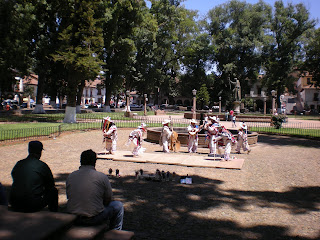The People. The Mexican people are un-failingly friendly, courteous, helpful, and kind. They are also honest and hard-working. For example, one day, while walking down the street, I pulled out my cell phone and inadvertently dropped some paper money on the sidewalk. While one man caught up with me to tell me of the situation, another man collected the money and brought it to me. While there are some beggars, in general, even the extremely poor people are working to make a living, whether it’s selling chewing gum, washing car windshields at a stop light, or serenading you while you dine at a sidewalk cafe. And no matter how badly I butchered the Spanish language, the Mexican people always smiled, figured out what I was trying to say, and provided the information that I requested.
The Spanish Legacy. Here in the central Highlands, the Spanish legacy is very strong. The main colonial towns are well designed, with lovely plazas, jardins, and other open spaces. Many of the buildings go far beyond the basic function of providing shelter, and provide massing and details that are a joy to view. This particularly applies to the almost innumerable churches. Because of the wealth being generated by the colony of Nueva Espana (New Spain), the Spanish were able to build (and to their credit elected to build) monumental churches that admirably reflected the styles and quality in vogue in Europe during the approximately 300 years that Spain ruled Mexico. As evidence of the quality of the Spanish efforts, several of these towns have been designated as UNESCO World Heritage sites. Unfortunately, the Spanish created these monuments using methods that we do not approve of today; most particularly the enslavement of the indigenous people.
Land in Transition. Today, Mexico is a land in transition, and consequently, a place of contrasts. A middle class is developing. City streets are full of people driving Honda SUVs and talking on cell phones. Wireless internet hot spots abound. Yet many of the people still live in grinding poverty, the enduring legacy of the social structure imposed by Spain, including the enslavement of the indigenous population.


Even in relatively prosperous Guanajuato, humans perform back-breaking tasks -- in this case, hauling away building debris.
 Quality of Life. From the perspective of a reasonably comfortable, but not wealthy American is that life in the Colonial Highlands of Mexico is a mixed bag. The historic centers of Guanajuato and Morelia offer a rich cultural life, with symphonies, theaters, and plazas filled with restaurants and entertainers. For example, one weekend nights in Guanajuato, a bands of entertainers dressed as Renaissance troubadors led a group of us on an hour-long walk through the narrow streets and small plazas of the city; singing and playing music along the way, and dancing and telling stories at various stops. I’m not aware of any U.S. city that has street life as vital and lively as that in Guanajuato
Quality of Life. From the perspective of a reasonably comfortable, but not wealthy American is that life in the Colonial Highlands of Mexico is a mixed bag. The historic centers of Guanajuato and Morelia offer a rich cultural life, with symphonies, theaters, and plazas filled with restaurants and entertainers. For example, one weekend nights in Guanajuato, a bands of entertainers dressed as Renaissance troubadors led a group of us on an hour-long walk through the narrow streets and small plazas of the city; singing and playing music along the way, and dancing and telling stories at various stops. I’m not aware of any U.S. city that has street life as vital and lively as that in GuanajuatoBut the historic centers are generally isolated pockets of quality set among areas of poverty and ugliness. We know that ugliness is often a by-product of poverty, but this is not always the case. Thailand, for example, exhibits much less ugliness in its poor areas.
Mexico could also be called a land of broken dreams. Everywhere, there are abandoned structures that serve as half-built memories of dreams of a better life. And unfortunately, the future for eliminating the ugliness does not look bright. As the cities grow, they despoil both the countryside with sprawl and the city with air pollution from cars and factories. Mexican developers seemed to have learned the worst lessons of American urban development and “improved” upon them.

We have looked at houses for rent and for sale in both Guanajuato, and have not found the right combination of price and quality so far. In fact, given the current foreclosure/short sale environment in the U.S., there are better bargains in Orlando. The solution is probably to find a new house built by an American who has become disillusioned with Mexico, moved back to the U.S., and is now willing to take a substantial loss to liquidate the property, but maybe that’s just me looking for a deal!
In short, we have enjoyed this trip immensely, but have not found the quality of life that we would need to bring us to Mexico long term. However, Saturday, we visited a smaller town named Patzcuaro that caught the attention of both of us. The overall quality of the town seems to be more to our liking. While there are no outstanding historic buildings, there also does not seem to be much really low quality neighborhoods. There are a reasonable number of Mexican tourists, and a smaller number of Americans, and collectively, they support a variety of small restaurants and shops around the main square. The question is whether this small town of 45,000 people offers enough cultural amenities to keep us entertained.




Another trip may be on the horizon!












































